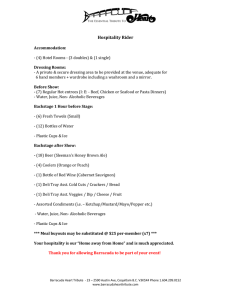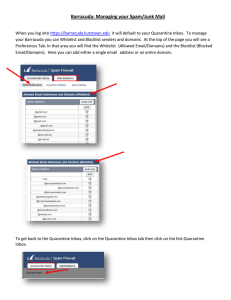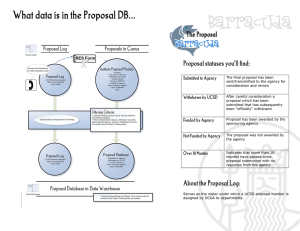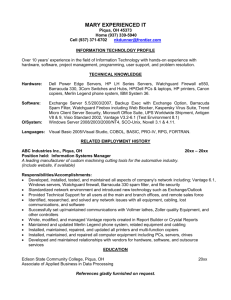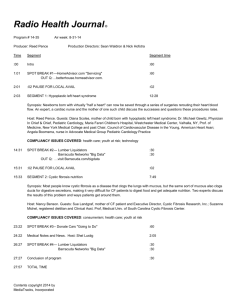Amador Valley High School
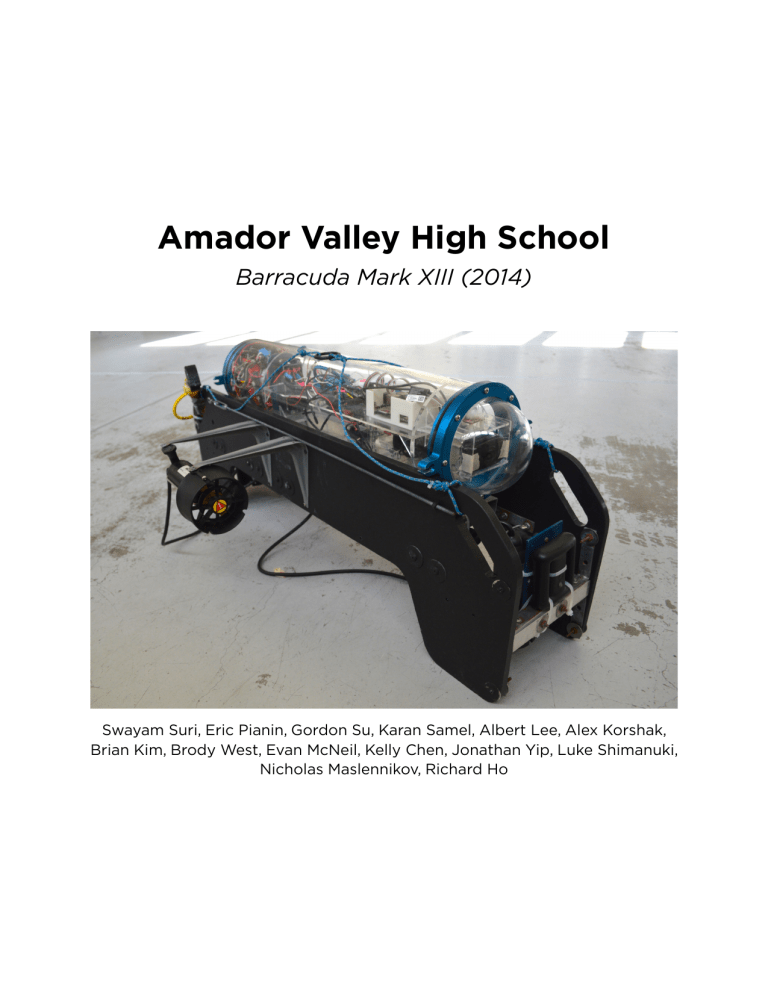
!
!
!
!
!
Amador Valley High School
Barracuda Mark XIII (2014)
Swayam Suri, Eric Pianin, Gordon Su, Karan Samel, Albert Lee, Alex Korshak,
!
!
!
!
Brian Kim, Brody West, Evan McNeil, Kelly Chen, Jonathan Yip, Luke Shimanuki,
Nicholas Maslennikov, Richard Ho
!
Abstract
Amador Valley High School students have created Barracuda XIII for the 17th annual International RoboSub Competition. Containing new mechanical peripherals and mission software, Barracuda XIII is more capable than ever.
This year’s developments include the introduction of a pneumatic system and peripherals, an improved kill switch, refined image processing, and a simulator to test software without having to put Barracuda in the water. The body of
Barracuda is made up of two high-density polyethylene side panels and a 6inch (15 cm) diameter acrylic tube which houses all the internal components.
Barracuda’s sensors include an inertial measurement unit (IMU), a pressure
!
sensor, two cameras, and four hydrophones.
The Team
In 1999, students from Amador Valley High School began competing at the
AUVSI International RoboSub Competition, then known as the AUV
Competition. This year, the 15 members of our team span all experience levels, from incoming freshmen to graduated seniors. All stages, from development to manufacturing to testing, are carried out entirely by students. With no technical advisors, the team must rely on self-education. Team o ffi cers devised a series of lectures to familiarize new members with mechanical, electrical, and software engineering concepts, allowing team members to understand how
!
Barracuda works without taking college-level classes.
In addition, the team has increased its community outreach this year by teaching robotics to middle-school students at Harvest Park Middle School, and by presenting to the public at the Alameda County Fair. The team hopes to increase interest in engineering among young children through this
!
outreach.
2014 Mission
AUVSI Foundation created this student competition in 1998 to increase interest in unmanned systems. The competition, now in its 17th year, is designed to simulate real-world tasks for autonomous submarines. These tasks include navigation, object recognition, object manipulation, passive sonar, and torpedo firing. In addition, vehicle weight and team presentation skills factor
!
!
!
into the scoring system.
Mechanical
Hull and Tube
The hull of the Barracuda is a 2 foot (60.9 cm) tube of acrylic, with an outer diameter of 6 inches (15.2 cm). The tube is attached to the side panels by a frame of 1 inch (2.5 cm) aluminium bars and L-brackets. The side panels are made of high-density polyethylene (HDPE) and serve as an external hard point to attach the motors, the lifting harness, and other components. Because the
Barracuda is light enough to be carried by two people, handles have been cut
!
into the side panels to assist in lifting the submarine.
Thrusters
The Barracuda uses 4 Seabotix BTD150 thrusters for vertical and horizontal propulsion. At full power, the thrusters draw 4.5 amperes of current and provide
21.6 Newtons of force. Two thrusters, mounted on aluminium plates in the front and the back of the submarine, control the depth and pitch. The other two thrusters are mounted on the side panels with aluminium L-brackets, controlling
!
speed and heading.
Endcaps
Barracuda uses two anodized aluminium end caps to keep a watertight seal inside the tube. The front end cap contains an acrylic dome that houses the
IMU and the forward facing camera. The rear end cap contains a set of 11 Brad-
Harrison connectors that handles all of the submarine’s signal and power I/O.
The connectors are rated to IP-68 and can be quickly attached and detached without disrupting the watertight seal. Both end caps have rubber O-rings fitted into grooves along their circumference, creating a water-tight seal when the end caps are in place. Uniform pressure is applied to the hull via two turnbuckles and threaded rods that are mounted on opposite sides of the end caps. This design reduces the torsional stress on the tube and provides
!
!
!
additional structural integrity.
Pneumatics
This year, we added a pneumatic system to the submarine. The goal is to power all of the auxiliary components, such as the dropper and the planned torpedo launcher, with this system. The system is powered by an on-board 15 cubic inch cylindrical plastic air tank rated to 125 psi. This air tank was chosen because it is very light and fits well on our current hull. The pressure is reduced from about 125 psi to about 30 psi working pressure, which is used for all of the components. The air tank is connected directly to the pressure regulator and the solenoid, which simplifies the entire setup,
!
reducing the possibility of air leaks.
Dropper - The dropper is a laser-cut acrylic structure with two main parts. The first part is a container fastened to one of the aluminium tubes on the underside of the submarine. The second part is a sliding acrylic piston attached to a pneumatic piston, which is a double acting cylinder that works by direct control. The cylinder is controlled with a 12 volt, 4/2 way solenoid valve. A one inch diameter stainless steel ball bearing is dropped into the top tube, and falls through a hole into the acrylic piston. The pneumatic cylinder then pushes the piston forward, where the hole aligns with the bottom tube.
The ball then falls through to land in the target area. This design was chosen because we can drop both markers with only one cylinder, which reduces the
!
number of pneumatic components needed to operate the dropper.
Kill Switch
In the past, a waterproof button was used for our kill switch. This needed two hands to operate comfortably and floated freely in the water behind the submarine, which was both inconvenient and hard to handle. In order to make the kill switch more convenient and user-friendly, we have upgraded to a two position toggle switch, which can be operated with one hand. This new kill switch is mounted directly to one of the
!
!
side panels for increased stability and ease of use.
Electrical
Batteries
Barracuda is powered by two Thunder Power RC 14.8-V four-cell lithium polymer batteries connected in parallel. The total energy capacity of the batteries is about 150 Wh, which allows our submarine to run for six to ten hours, depending on the tasks being executed. These batteries were chosen because of their ability to supply large amounts of burst current, which accommodates the inrush current of powering the motors.
!
Power Supply
LMZ12010 simple switcher. The LMZ12010 was chosen for its shielded inductor to the switching
IC. An undervoltage lockout system turns o ff the power supply when the battery voltage drops under 12V, thus, turning o ff the motor controller. Low-ESR tantalum and ceramic capacitors help reduce ripple.
Aside from the thrusters, which run on 14.8 V, all of Barracuda’s internal electronics run on 5 V. To accommodate this, Barracuda uses a buck converter based on the Texas Instruments
Main Computer
The Hardkernel ODROID-X serves as Barracuda’s main computer. It runs on 10 watts of power and contains a
Samsung Exenos4412 Cortex-A9 Quad Core 1.4GHz processor and 1GB of RAM. The ODROID-X handles
Barracuda’s image processing and mission planning, and it communicates with the mbed and cameras through USB. The ODROID-X is 10 times faster than our
!
previous computer, the BeagleBoard.
Control Board
Barracuda’s control board includes the mbed LPC1768, which has a 32 bit, 96-
MHz ARM Cortex M3 processor, 512 KB of flash memory, and 32 KB of useraccessible RAM. It monitors various sensors and probes, which provide the submarine with various measurements and readings. The mbed is used for low-level tasks, such as motor control, processing data from our Inertial
Measurement Unit (IMU), reading data from the pressure sensor, and
determining pinger location from timestamps of our four hydrophones. This year, we transferred the mbed from a breadboard to a printed circuit board
(PCB) to increase reliability. This allowed us to add several new features to the control board, including a leak detector, a battery voltage sensor, and a temperature sensor.
!
Motor and Servo Controllers
Barracuda’s servo controller is the 12-channel Pololu
Mini Maestro. It receives Serial signals from the control board and outputs pulse-width modulation
!
(PWM) to Barracuda’s four motor controllers.
Motor Drivers
Barracuda’s four Motor drivers are Novak Super
Roosters. The Super Roosters change the voltages applied to the thrusters according to PWM input from the servo controller. Since the Super Roosters generate significant heat, they are arranged around the rear aluminium cap to dissipate heat into the water.
Wi-Fi Tether
Barracuda’s Wi-Fi tether contains a wireless router and a battery pack, both stored in a waterproof Pelican case. The access point is wired to the main computer via an ethernet cable that passes through the rear end cap. The tether allows us to upload code to the main computer and control board during testing, allowing us to save time by having the
!
operators debug while the vehicle is still in the water.
Navigation Sensors (IMU and
Pressure Sensor)
Barracuda’s IMU is the 9DOF Spark Fun Razor. It has nine degrees of freedom with its triple-axis accelerometer, triple-axis gyroscope, and tripleaxis magnetometer. Barracuda does not use the magnetometer because its performance is hindered by the changing magnetic fields caused
by the thrusters; instead the accelerometers and gyroscopes determine
!
heading and pitch of the submarine.
Barracuda’s pressure sensor is the Ashcroft Model K1 Pressure Transducer/
Transmitter. It converts pressure readings of the water into voltage readings, which are linearly converted to depth by the mbed.
Signal Processing
Barracuda uses four Reson TC4013 hydrophones to capture audio from the pinger. Surfboard, a custom digital-signalprocessing board, determines the pinger’s location. Incoming signals are amplified through a four-channel op-amp with low-pass filters. Then, they are passed to the Texas
Instruments ADS1274 analog-to-digital converter to be digitized at a sample rate of
105 kHz. The ADS1274 was selected for its fast conversion time and ease of use. An mbed LPC1768 processes the signals and sends the timestamp of each
!
pulse to the control mbed inside the submarine.
Digital and analog circuitry are isolated to prevent high-speed digital noise from entering sensitive analog circuitry. Analog circuitry is powered by small lithium-polymer batteries near the board to avoid switching noise.
!
Cameras
Barracuda’s front-facing and downward-facing cameras are 720p Logitech c525 webcams.
The high resolution of the cameras gives us the option of oversampling to reduce noise that can interfere with image processing.The
Logitech c525 cameras automatically focus anything farther than seven centimeters from their lenses.
!
!
Actuator Control
To control the pneumatic solenoids, Barracuda uses a SainSmart 4-Channel
Relay Module. The module is controlled by the mbed and switches 14.8 V
battery current for the solenoids. A 4-Channel module gives us the capacity to
!
add more external peripherals in the future.
Software
Extensive Vehicular Automaton (EVA)
EVA runs on the ODROID-X and carries out mission planning and vision
!
processing functions.
Mission Control EVA is composed of separate classes for each task and image processing functions with a main class that controls the order of these tasks.
Tasks related with hardware communication are not part of EVA in order to debug mission logic without rewriting or interrupting communication with hardware. When running tasks it reads variables from a configuration file that we can manipulate to change the order of the attempted tasks and individual values used in each task. Furthermore, EVA dynamically searches for tasks that are most likely to succeed, so if Barracuda finds a path or a buoy, it can
!
proceed to that task.
Image Processing- Image processing in EVA uses OpenCV for the image processing pipeline that starts with converting images to a more usable RGB format. Color enhancements are then applied to make task items stand out and followed by thresholding to isolate the object of interest. Additional image processing pertaining to each separate task is carried out. For example, if we try to locate buoys, we run a circularity test to determine how circular an object is to determine if the object detected is a buoy. Similarly, if we want to align Barracuda over a path, we calculate the angles of the edges of our path and change directions accordingly.
!
!
Logging- In order to understand and analyze what the submarine completes during its run, we save the state of Barracuda and sub-operations performed
with each task attempted. We also record the images that are taken with the enhanced and fully processed images. These logs are crucial to understand errors in our code for further debugging.
!
Multithreading - To use the most of the ODROID-X, EVA utilizes a custom thread pool to process images received from our front and down facing HD webcams. By dividing images four ways, we can perform image processing more quickly, improving our frames per second performance and thus keeping a better track of the objects that must be accounted for when running the
!
mission.
AVNavControl
AVNavControl, which runs on the mbed, is responsible for relaying hardware data from the kill switch, IMU, pressure sensor, and the hydrophone board to
EVA. It also sets the direction, motor speed, and depth based on what is set
!
by EVA during a mission task.
Motor Control - AVNavControl uses three proportional-integral-derivative
(PID) controllers to control the pitch, heading, and depth of Barracuda. The pitch is determined by running a Kalman Filter with gyroscope data in parallel with accelerometer data. Our heading is determined by an accumulated integral of gyroscope readings during each run. Barracuda gets its depth by referring to a preset linear model of pressure to depth values. Given these PID values, we can set power to our side motors to change heading, and power to the downward facing motors to control pitch and depth to orient the state of
!
!
Barracuda for the task at hand.
Surfboard
Surfboard runs on a second mbed LPC1768 and processes the digital signal from the ADC to locate the pinger. Direct memory access is used to receive the signal, allowing the mbed to transfer data using less processing power and reserving resources for other processes. To find the pinger, Barracuda uses an
IIR band-pass filter on all four channels to attenuate the frequencies that could not have been transmitted by the pinger. Next, the filtered waves are analyzed to find the start of the wave in each channel. The relative time that the wave starts in each channel is transmitted to the control mbed, which uses time di ff erence of arrival (TDOA) to calculate the location of the pinger with
!
respect to the submarine.
Barracuda Simulator
The simulator is a project we started this year in order to test our code without the need to deploy the actual submarine and its cameras. By creating a virtual environment in which EVA can interact and receive real-time feedback, it allows us to test the validity of our ideas and debug code with better e ffi ciency, as the simulator can be run on each individual’s personal computer. The simulator also enables us to make more productive use of our time during water tests by eliminating the possibility of major bugs in our code that require more attention than could be given at the poolside.
!
The simulator emulates the mbed (AVNavControl) and cameras by creating a virtual environment in Blender, the free and open-source 3D modeling software. The advantage of using Blender is the ability to quickly and easily change the layout of the environment to our needs. Normally, EVA interprets camera data and sends desired heading, depth, and power to the mbed via a serial connection. In comparison, the simulator creates a virtual serial port to which EVA can send data, and it performs adjustments in the virtual environment. It saves an image of this virtual environment periodically, which
!
EVA can read and interpret.
Conclusion
Significant advancements made this year will allow our AUV, Barracuda Mark
XIII, to complete the new challenges presented by the 17th AUVSI RoboSub
Competition. With increased documentation, we hope that the team will retain
!
more knowledge as members graduate.
Acknowledgements
We would like to thank our past members for o ff ering advice and help to us in times of need: Je ff Chen, Kevin Chen, and Aditya Sinha. We thank our faculty advisor, Bree Barnett Dreyfuss, for use of her classroom throughout the year
!
as a regular meeting place.
We would also like to thank our sponsors: Bloomfire, Bluehost, GitHub, mbed,
!
and the Pleasanton Rotary Club.
Without our supporters, this project would not be possible.
